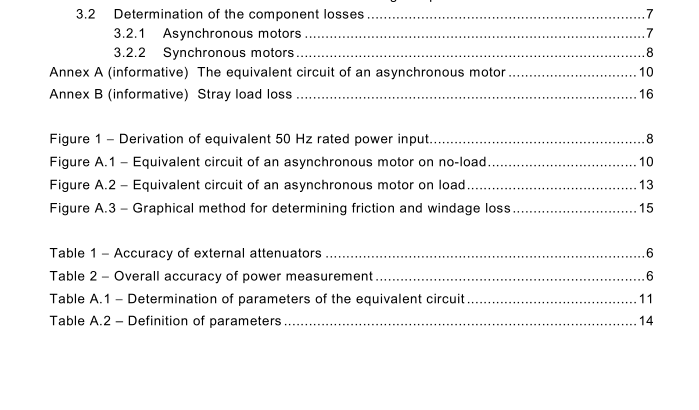IEC TS 60349-3:2010 pdf download – Electric traction – Rotating electrical machines for rail and road vehicles – Part 3: Determination of the total losses of converter-fed alternating current motors by summation of the component losses
1 Scope and object
This technical specification applies to machines complying with IEC 60349-2. The total losses of a converter-fed motor may be determined by summation of the component losses derived from no-load and load tests.
The total input power is the sum of the power at the fundamental frequency and at all other frequencies. In all practical cases the latter input includes the losses resulting from the voltage and current harmonics in the converter supply by using suitable instrumentation it can be derived from measurement of the total and fundamental frequency power inputs when the machine is on load. The losses supplied at the fundamental frequency cannot be measured directly and so are derived from measurement of the fundamental frequency load current and the fundamental frequency no-load power input.
2 Instrumentation
The extra loss due to operation on a converter supply is obtained from the difference of the total and fundamental frequency power input on load. The power inputs shall be measured simultaneously on each phase by a digital sampling instrument. Measurement on all three phases is preferred but the two wattmeter method is permissible as an alternative.
The total power is obtained from the product of voltage and current over a period of time and the fundamental power from a Fourier transform using the same sampling. It is necessary to consider the accuracy of the whole instrument chain taking into account both amplification and phase shift errors over the desired frequency range.
As the power factor of the harmonics is generally very low (less than 0,1 for voltage imposed asynchronous systems) particular attention is drawn to the need for minimum phase angle errors.
At the time of publication of this technical specification, wattmeters accurate within the following limits, at 0,08 power factor, were available:
below 2 kHz ±0,5 %;
between 2 kHz and 20 kHz ±1 ,0 %;
between 20 kHz and 50 kHz ±2,0 %.
Instruments often contain attenuators compensated and adapted to them, but if an external attenuator is used, it is desirable that it be accurate within the following limits given in Table 1 .
NOTE The frequency range over which measurements are necessary depends on the harmonic content of the output from the particular converter used and should therefore be decided for each individual case. With the instrumentation presently available, the overall accuracy of the total harmonic loss measurement is likely to be of the order of ±1 0 %, but as the loss is unlikely to exceed 3 % of the total power input, this will result in only 0,3 % error in the calculated torque, which is well within the permitted tolerance of −5 % specified in IEC 60349-2.
At the time of publication of this technical specification, current transformers are significantly less accurate at the low power factors and high harmonic frequencies involved than non-inductive shunts, which can have a ratio accuracy within ±1 % and a phase shift within ±0,2°.
3 Summation of losses
3.1 The total losses are the sum of the following component losses.
3.1.1 Losses supplied at the fundamental frequency on no-load (no-load losses):
− losses in the active iron and other metal parts;
− losses due to friction and windage including the power absorbed by integral fans.
3.1.2 Losses which occur when the motor is supplied at the fundamental frequency and which vary with load (load dependent losses):
− I 2 R losses in the stator windings;
− I 2 R losses in the rotor winding of asynchronous motors;
− additional load losses (load loss) consisting of:
• losses in the active iron and metal parts other than the conductors;
• eddy current losses in the stator and rotor windings arising from current dependent flux pulsation.
3.1.3 Losses supplied at other than the fundamental frequency.
3.1.4 I 2 R and brush contact losses in the excitation circuit of synchronous motors.IEC TS 60349-3 pdf download.
